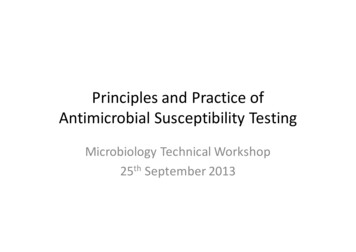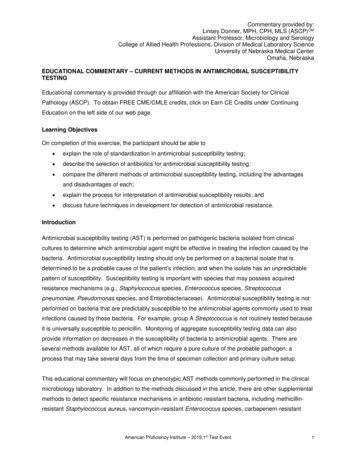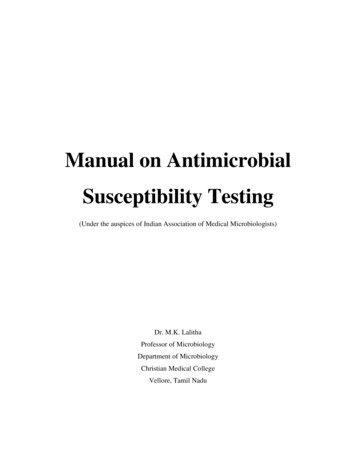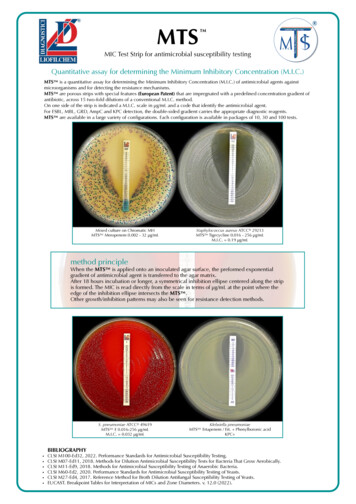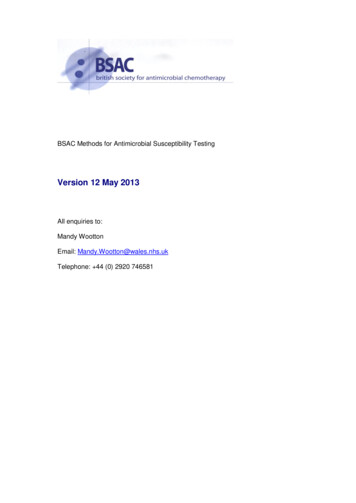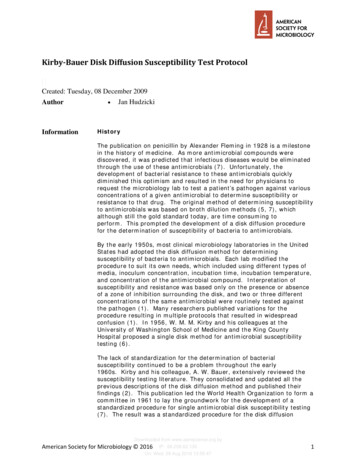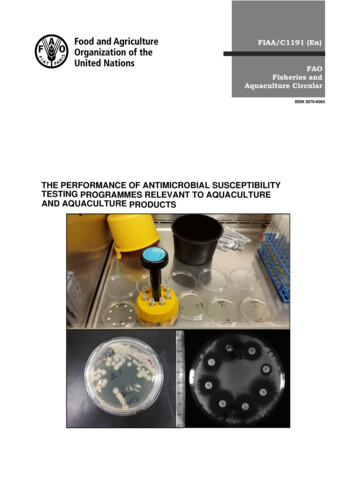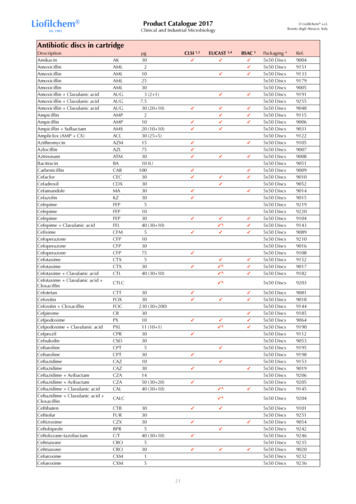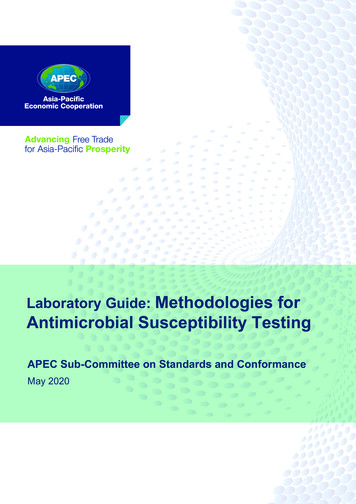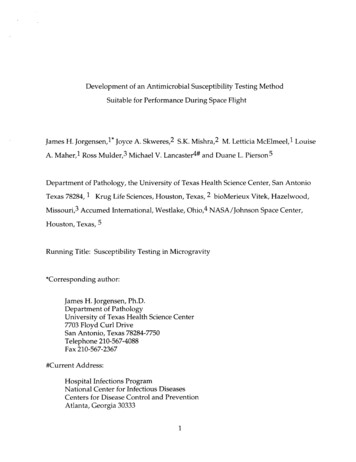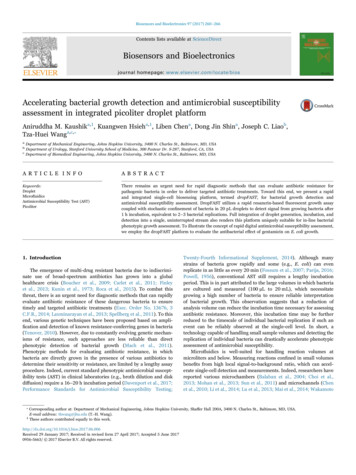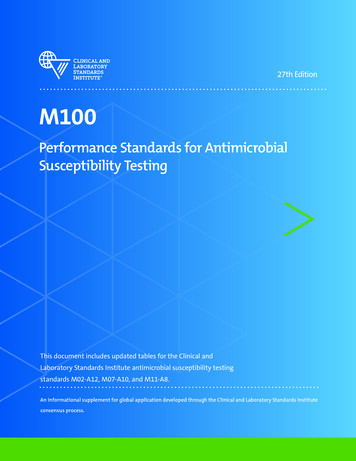
Transcription
27th EditionM100Performance Standards for AntimicrobialSusceptibility TestingThis document includes updated tables for the Clinical andLaboratory Standards Institute antimicrobial susceptibility testingstandards M02-A12, M07-A10, and M11-A8.An informational supplement for global application developed through the Clinical and Laboratory Standards Instituteconsensus process.
Clinical and Laboratory Standards InstituteSetting the standard for quality in medical laboratory testing around the world.The Clinical and Laboratory Standards Institute (CLSI) is a not-for-profit membership organization that bringstogether the varied perspectives and expertise of the worldwide laboratory community for the advancement of acommon cause: to foster excellence in laboratory medicine by developing and implementing medical laboratorystandards and guidelines that help laboratories fulfill their responsibilities with efficiency, effectiveness, and globalapplicability.Consensus ProcessConsensus—the substantial agreement by materially affected, competent, and interested parties—is core to thedevelopment of all CLSI documents. It does not always connote unanimous agreement, but does mean that theparticipants in the development of a consensus document have considered and resolved all relevant objectionsand accept the resulting agreement.Commenting on DocumentsCLSI documents undergo periodic evaluation and modification to keep pace with advancements in technologies,procedures, methods, and protocols affecting the laboratory or health care.CLSI’s consensus process depends on experts who volunteer to serve as contributing authors and/or as participantsin the reviewing and commenting process. At the end of each comment period, the committee that developedthe document is obligated to review all comments, respond in writing to all substantive comments, and revise thedraft document as appropriate.Comments on published CLSI documents are equally essential, and may be submitted by anyone, at any time, onany document. All comments are managed according to the consensus process by a committee of experts.Appeals ProcessWhen it is believed that an objection has not been adequately considered and responded to, the process forappeals, documented in the CLSI Standards Development Policies and Processes, is followed.All comments and responses submitted on draft and published documents are retained on file at CLSI and areavailable upon request.Get Involved—Volunteer!Do you use CLSI documents in your workplace? Do you see room for improvement? Would you like to getinvolved in the revision process? Or maybe you see a need to develop a new document for an emergingtechnology? CLSI wants to hear from you. We are always looking for volunteers. By donating your time and talentsto improve the standards that affect your own work, you will play an active role in improving public health acrossthe globe.For additional information on committee participation or to submit comments, contact CLSI.Clinical and Laboratory Standards Institute950 West Valley Road, Suite 2500Wayne, PA 19087 USAP: 1.610.688.0100F: 1.610.688.0700www.clsi.orgstandard@clsi.org
M100, 27th ed.January 2017Replaces M100-S26Performance Standards for Antimicrobial Susceptibility TestingJean B. Patel, PhD, D(ABMM)Melvin P. Weinstein, MDGeorge M. Eliopoulos, MDStephen G. Jenkins, PhD, D(ABMM), F(AAM)James S. Lewis II, PharmDBrandi Limbago, PhDAmy J. Mathers, MDTony Mazzulli, MD, FRCP (C), FACPRobin Patel, MDSandra S. Richter, MD, D(ABMM)Michael Satlin, MD, MSJana M. Swenson, MMScMaria M. Traczewski, BS, MT(ASCP)John D. Turnidge, MDM100S, 26th ed.Barbara L. Zimmer, PhDJanuary 2016Replaces M100-S25Performance Standards for Antimicrobial Susceptibility TestingAbstractThe data in the interpretive tables in this supplement are valid only if the methodologies in the following Clinical and LaboratoryJean B.InstitutePatel, PhD,D(ABMM) standards are followed: M02-A12—Performance Standards for Antimicrobial DiskStandards(CLSI)–approvedFranklin ests;ApprovedEdition; M07-A10—Methods for Dilution Antimicrobial Susceptibility TestsM. Eliopoulos,forGeorgeBacteriaThat MD dM11-A8—Methodsfor AntimicrobialSusceptibilityTesting of Anaerobic Bacteria; Approved Standard—Eighth Edition. TheStephen G. Jenkins,PhD, D(ABMM),F(AAM)standardsinformationabout both disk (M02) and dilution (M07 and M11) test procedures for aerobic and anaerobicJames containS. LewisII, PharmDbacteria.Brandi Limbago, PhDDavid P.Nicolau,PharmD,FCCP, fromFIDSACliniciansdependheavilyon informationthe microbiology laboratory for treatment of their seriously ill patients. TheRobinPatel, MDclinicalimportanceof antimicrobial susceptibility test results demands that these tests be performed under optimal conditions andthatMairlaboratoriestheFRCP,capabilityto provide results for the newest antimicrobial agents.Powell,haveMD,FRCPathSandra S. Richter, MD, D(ABMM)The tabular information presented here represents the most current information for drug selection, interpretation, and QC usingJana M. Swenson, MMScthe procedures standardized in the most current editions of M02, M07, and M11. Users should replace the tables published earlierMariaBS,inMT(ASCP)withthese M.newTraczewski,tables. (Changesthe tables since the previous edition appear in boldface type.)John D. Turnidge, MD Institute (CLSI). Performance Standards for Antimicrobial Susceptibility Testing. 27th ed.CLSIsupplementM100 (ISBNBarbaraL. Zimmer,PhD 1-56238-804-5 [Print]; ISBN 1-56238-805-3 [Electronic]). Clinical and Laboratory StandardsInstitute, 950 West Valley Road, Suite 2500, Wayne, Pennsylvania 19087 USA, 2017.The Clinical and Laboratory Standards Institute consensus process, which is the mechanism for moving a document throughtwo or more levels of review by the health care community, is an ongoing process. Users should expect revised editions of anygiven document. Because rapid changes in technology may affect the procedures, methods, and protocols in a standard orguideline, users should replace outdated editions with the current editions of CLSI documents. Current editions are listed inthe CLSI catalog and posted on our website at www.clsi.org. If you or your organization is not a member and would like tobecome one, and to request a copy of the catalog, contact us at: Telephone: 1.610.688.0100; Fax: 1.610.688.0700; E-Mail:customerservice@clsi.org; Website: www.clsi.org.
M100, 27th ed.Copyright 2017 Clinical and Laboratory Standards Institute. Except as stated below, any reproduction ofcontent from a CLSI copyrighted standard, guideline, companion product, or other material requiresexpress written consent from CLSI. All rights reserved. Interested parties may send permission requests topermissions@clsi.org.CLSI hereby grants permission to each individual member or purchaser to make a single reproduction ofthis publication for use in its laboratory procedures manual at a single site. To request permission to usethis publication in any other manner, e-mail permissions@clsi.org.Suggested CitationCLSI. Performance Standards for Antimicrobial Susceptibility Testing. 27th ed. CLSI supplement M100.Wayne, PA: Clinical and Laboratory Standards Institute; 2017.Previous Editions:December 1986, December 1987, December 1991, December 1992, December 1994, December 1995,January 1997, January 1998, January 1999, January 2000, January 2001, January 2002, January 2003,January 2004, January 2005, January 2006, January 2007, January 2008, January 2009, January 2010,June 2010, January 2011, January 2012, January 2013, January 2014, January 2015, January 2016ISBN 1-56238-804-5 (Print)ISBN 1-56238-805-3 (Electronic)ISSN 1558-6502 (Print)ISSN 2162-2914 (Electronic)iiVolume 37, Number 1
M100, 27th ed.Committee MembershipSubcommittee on Antimicrobial Susceptibility TestingJean B. Patel, PhD, D(ABMM)ChairholderCenters for Disease Control andPreventionUSAMelvin P. Weinstein, MDVice-ChairholderRutgers Robert Wood Johnson MedicalSchoolUSAGeorge M. Eliopoulos, MDBeth Israel Deaconess Medical CenterUSAStephen G. Jenkins, PhD, D(ABMM),F(AAM)New York Presbyterian/ColumbiaUniversity Medical CenterUSAJames S. Lewis II, PharmDOregon Health and Science UniversityUSASandra S. Richter, MD, D(ABMM)Cleveland ClinicUSABrandi Limbago, PhDCenters for Disease Control andPreventionUSAMichael Satlin, MD, MSWeill Cornell Medical CollegeUSAAmy J. Mathers, MDUniversity of Virginia Medical CenterUSAJohn D. Turnidge, MDAustralian Commission on Safetyand Quality in Health CareAustraliaTony Mazzulli, MD, FRCP (C), FACPMount Sinai HospitalCanadaBarbara L. Zimmer, PhDBeckman Coulter - West SacramentoUSARobin Patel, MDMayo ClinicUSAAcknowledgmentCLSI, the Consensus Council, and the Subcommittee on Antimicrobial Susceptibility Testing gratefullyacknowledge the following volunteers for their important contributions to the development of thisdocument:Jana M. Swenson, MMScUSAMaria M. Traczewski, BS,MT(ASCP)The Clinical Microbiology InstituteUSAWorking Group on AST BreakpointsGeorge M. Eliopoulos, MDCo-ChairholderBeth Israel Deaconess Medical CenterUSAJames S. Lewis II, PharmDCo-ChairholderOregon Health and Science UniversityUSAKaren Bush, PhDCommittee SecretaryIndiana UniversityUSAMarcelo F. GalasNational Institute of Infectious DiseasesArgentinaAmy J. Mathers, MDUniversity of Virginia Medical CenterUSADavid P. Nicolau, PharmD, FCCP, FIDSAHartford HospitalUSAMichael Satlin, MD, MSWeill Cornell Medical CollegeUSAAudrey N. Schuetz, MD, MPH,D(ABMM)Mayo ClinicUSASimone ShurlandFDA Center for Devices andRadiological HealthUSALauri D. Thrupp, MDUCI Medical Center (University ofCalifornia, Irvine)USAHui Wang, PhDPeking University People’s HospitalChinaMelvin P. Weinstein, MDRobert Wood Johnson UniversityHospitalUSAMatthew A. Wikler, MD, MBA,FIDSAUSABarbara L. Zimmer, PhDBeckman Coulter – West SacramentoUSAiii
M100, 27th ed.Working Group on Methods Application and InterpretationStephen G. Jenkins, PhD, D(ABMM),F(AAM)Co-ChairholderNew York Presbyterian /ColumbiaUniversity Medical CenterUSABrandi Limbago, PhDCo-ChairholderCenters for Disease Control andPreventionUSAKristie Johnson, PhD, D(ABMM)University of Maryland Medical SystemUSAThomas J. Kirn, Jr, MD, PhDRobert Wood Johnson UniversityHospitalUSASandra S. Richter, MD, D(ABMM)Cleveland ClinicUSAJoseph Kuti, PharmDHartford HospitalUSADarcie E. Roe-Carpenter, PhD, CIC,CEMBeckman Coulter - West SacramentoUSASamir Patel, PhD, D(ABMM), FCCMPublic Health OntarioCanadaSusan Sharp, PhD, D(ABMM), F(AAM)Kaiser Permanente-NWUSAVirginia M. Pierce, MDMassachusetts General HospitalUSARibhi M. Shawar, PhD, D(ABMM)FDA Center for Devices andRadiological HealthUSAWorking Group on Methods Development and StandardizationDwight J. Hardy, PhDCo-ChairholderUniversity of Rochester MedicalCenterUSABarbara L. Zimmer, PhDCo-ChairholderBeckman Coulter - West SacramentoUSAKatherine SeiSecretaryBeckman Coulter - West SacramentoUSAivWilliam B. BrassoBD Diagnostic SystemsUSALaura M. Koeth, MT(ASCP)Laboratory Specialists, Inc.USARomney M Humphries, PhD,D(ABMM), M(ASCP)CMUCLA Medical CenterUSARibhi M. Shawar, PhD, D(ABMM)FDA Center for Devices andRadiological HealthUSA
M100, 27th ed.Working Group on Quality ControlSteven D. Brown, PhD, (D)ABMMCo-ChairholderUSAStephen Hawser, PhDIHMA Europe SàrlSwitzerlandRoss Mulder, MT(ASCP)bioMérieux, Inc.USASharon K. Cullen, BS, RACCo-ChairholderBeckman Coulter – West SacramentoUSAJanet A. Hindler, MCLS, MT(ASCP)UCLA Medical CenterUSASusan D. Munro, MT(ASCP), CLSUSAPatricia S. Conville, MS, MT(ASCP)FDA Center for Devices and RadiologicalHealthUSADana C. Dressel, MT(ASCP)International Health ManagementAssociates, Inc.USAKerian K. Grande Roche, PhDFDA Center for Devices and RadiologicalHealthUSADenise Holliday, MT(ASCP)BD Diagnostic SystemsUSAMichael D. Huband, BSJMI LaboratoriesUSAChris Pillar, PhDMicromyx, LLCUSAMary K. York, PhD, ABMMMKY Microbiology ConsultingUSAErika Matuschek, PhDESCMIDSwitzerlandWorking Group on Text and TablesJana M. Swenson, MMScCo-ChairholderUSADyan Luper, BS, MT(ASCP)SM, MBBD Diagnostic SystemsUSAFlavia Rossi, MDUniversity of São PauloBrazilMaria M. Traczewski, BS, MT(ASCP)Co-ChairholderThe Clinical Microbiology InstituteUSALinda M. Mann, PhD, D(ABMM)USADale A. Schwab, PhD, D(ABMM)Quest Diagnostics Nichols InstituteUSACarey-Ann Burnham, PhD, D(ABMM)Committee SecretaryWashington University School ofMedicineUSAJanet A. Hindler, MCLS, MT(ASCP)UCLA Medical CenterUSAPeggy Kohner, BS, MT(ASCP)Mayo ClinicUSAMelissa B. Miller, PhD, D(ABMM),F(AAM)UNC HospitalsUSAShelley Miller, PhD, D(ABMM),M(ASCP), PHMUCLA Medical CenterUSASusan D. Munro, MT(ASCP), CLSUSAL. Barth Reller, MDDuke University Medical CenterUSARichard B. Thomson, Jr., PhD,D(ABMM), FAAMEvanston Hospital, NorthShoreUniversity HealthSystemUSANancy E. Watz, MS, MT(ASCP),CLSStanford Health CareUSAMary K. York, PhD, ABMMMKY Microbiology ConsultingUSAv
M100, 27th ed.StaffClinical and LaboratoryStandards InstituteUSATracy A. Dooley, MLT(ASCP)Project ManagerMarcy Hackenbrack, MCM,M(ASCP)Project ManagerviMegan L. Tertel, MA, ELSEditorial ManagerJoanne P. Christopher, MA, ELSEditorLaura MartinEditorMichael A. Russell, MAEditor
M100, 27th ed.This page is intentionally left blank.vii
Table of ContentsAbstract . iCommittee Membership. iiiSummary of Changes . xivSummary of CLSI Processes for Establishing Breakpoints and Quality Control Ranges . xxiiCLSI Reference Methods vs Commercial Methods and CLSI vs US Food and Drug Administration Breakpoints . xxxiiiCLSI Breakpoint Additions/Revisions Since 2010 . xxivSubcommittee on Antimicrobial Susceptibility Testing Mission Statement . xxviiInstructions for Use of Tables . 1Table 1A. Suggested Groupings of Antimicrobial Agents Approved by the US Food and Drug Administration for Clinical Use ThatShould Be Considered for Testing and Reporting on Nonfastidious Organisms by Microbiology Laboratories in the United States . 18Table 1B. Suggested Groupings of Antimicrobial Agents Approved by the US Food and Drug Administration for Clinical Use ThatShould Be Considered for Routine Testing and Reporting on Fastidious Organisms by Microbiology Laboratories in the United States . 24Table 1C. Suggested Groupings of Antimicrobial Agents Approved by the US Food and Drug Administration for Clinical UseThat Should Be Considered for Testing and Reporting on Anaerobic Organisms by Microbiology Laboratories in the United States . 30Tables 2A–2J. Zone Diameter and Minimal Inhibitory Concentration Breakpoints for:2A-1. Enterobacteriaceae . 322A-2. Epidemiological Cutoff Values for Enterobacteriaceae . 402B-1. Pseudomonas aeruginosa . 42M100, 27th ed.viiiContents
Contents (Continued)2B-2. Acinetobacter spp. 462B-3. Burkholderia cepacia complex . 502B-4. Stenotrophomonas maltophilia . 522B-5. Other Non-Enterobacteriaceae . 542C. Staphylococcus spp. . 562D. Enterococcus spp. . 642E. Haemophilus influenzae and Haemophilus parainfluenzae . 682F-1. Neisseria gonorrhoeae . 722F-2. Epidemiological Cutoff Values for Neisseria gonorrhoeae . 762G. Streptococcus pneumoniae . 782H-1. Streptococcus spp. β-Hemolytic Group . 842H-2. Streptococcus spp. Viridans Group . 882I. Neisseria meningitidis . 922J-1. Anaerobes. 962J-2. Epidemiological Cutoff Values for Propionibacterium acnes . 100ixTable of ContentsM100, 27th ed.Table 3A. Tests for Extended-Spectrum β-Lactamases in Klebsiella pneumoniae, Klebsiella oxytoca, Escherichia coli, andProteus mirabilis. 102
Table of ContentsIntroduction to Tables 3B, 3C, and 3D. Tests for Carbapenemases in Enterobacteriaceae, Pseudomonas aeruginosa, andAcinetobacter spp. 106Table 3B. The Modified Hodge Test for Suspected Carbapenemase Production inEnterobacteriaceae . 108Table 3B-1. Modifications of Table 3B When Using Breakpoints for CarbapenemsDescribed in M100-S20 (January 2010). 110Table 3C. Carba NP Test for Suspected Carbapenemase Production in Enterobacteriaceae, Pseudomonas aeruginosa, andAcinetobacter spp. . 114Table 3C-1. Modifications of Table 3C When Using Minimal Inhibitory ConcentrationBreakpoints for Carbapenems Described in M100-S20 (January 2010) . 118Table 3D. Modified Carbapenem Inactivation Method (mCIM) for Suspected Carbapenemase Production inEnterobacteriaceae . 122Table 3D-1. Modifications of Table 3D When Using Minimal Inhibitory Concentration Breakpoints for CarbapenemsDescribed in M100-S20 (January 2010) . 125Table 3E. Test for Detection of β-Lactamase Production in Staphylococcus species . 128Table 3F. Test for Detection of Methicillin Resistance (Oxacillin Resistance) in Staphylococcusspecies, Except Staphylococcus pseudintermedius . 132Table 3G. Vancomycin Agar Screen for Staphylococcus aureus and Enterococcus species . 134Table 3H. Test for Detection of Inducible Clindamycin Resistance in Staphylococcus species, Streptococcus pneumoniae, andStreptococcus spp. β-Hemolytic Group . 136Table 3I. Test for Detection of High-Level Mupirocin Resistance in Staphylococcus aureus . 140M100, 27th ed.xContents (Continued)
Contents (Continued)Table 3J. Test for Detection of High-Level Aminoglycoside Resistance in Enterococcus species(Includes Disk Diffusion) . 142Table 4A. Disk Diffusion: Quality Control Ranges for Nonfastidious Organisms (Unsupplemented Mueller-Hinton Medium) . 144Table 4B. Disk Diffusion: Quality Control Ranges for Fastidious Organisms . 150Table 4C. Disk Diffusion: Reference Guide to Quality Control Frequency . 154Table 4D. Disk Diffusion: Troubleshooting Guide. 158Table 5A. MIC: Quality Control Ranges ( g/mL) for Nonfastidious Organisms (Unsupplemented Mueller-Hinton Medium [CationAdjusted if Broth]) . 162Table 5B. MIC: Quality Control Ranges for Fastidious Organisms (Broth Dilution Methods) . 168Table 5C. MIC: Quality Control Ranges for Neisseria gonorrhoeae (Agar Dilution Method) . 172Table 5D. MIC: Quality Control Ranges for Anaerobes (Agar Dilution Method) . 174Table 5E. MIC: Quality Control Ranges for Anaerobes (Broth Microdilution Method). 176Table 5F. MIC: Reference Guide to Quality Control Frequency. 178Table 5G. MIC: Troubleshooting Guide . 182Table 6A. Solvents and Diluents for Preparation of Stock Solutions of Antimicrobial Agents . 186Table 6B. Preparation of Stock Solutions for Antimicrobial Agents Provided With Activity Expressed as Units. . 192Table 7A. Scheme for Preparing Dilutions of Antimicrobial Agents to Be Used in Agar Dilution Susceptibility Tests. 198xiTable of ContentsM100, 27th ed.Table 6C. Preparation of Solutions and Media Containing Combinations of Antimicrobial Agents . 194
Table of ContentsTable 8A. Scheme for Preparing Dilutions of Antimicrobial Agents to Be Used in Broth Dilution Susceptibility Tests . 200Table 8B. Scheme for Preparing Dilutions of Water-Insoluble Antimicrobial Agents to Be Used in Broth Dilution SusceptibilityTests . 202Appendix A. Suggestions for Confirmation of Resistant (R), Intermediate (I), or Nonsusceptible (NS) Antimicrobial SusceptibilityTest Results and Organism Identification . 204Appendix B. Intrinsic Resistance . 210Appendix C. Quality Control Strains for Antimicrobial Susceptibility Tests. 216Appendix D. Cumulative Antimicrobial Susceptibility Report for Anaerobic Organisms. 222Appendix E. Dosing Regimens Used to Establish Susceptible or Susceptible-Dose DependentBreakpoints . . 228Appendix F. Cefepime Breakpoint Change for Enterobacteriaceae and Introduction of the Susceptible-Dose Dependent InterpretiveCategory . 230Appendix G. Epidemiological Cutoff Values . 234Glossary I (Part 1). β-Lactams: Class and Subclass Designations and Generic Name . 236Glossary I (Part 2). Non–β-Lactams: Class and Subclass Designations and Generic Name . 238Glossary II. Abbreviations/Routes of Administration/Drug Class for Antimicrobial Agents Listed in M100, 27th ed. . 240Glossary III. List of Identical Abbreviations Used for More Than One Antimicrobial Agent in US Diagnostic Products. 246The Quality Management System Approach . 248Related CLSI Reference Materials . 249M100, 27th ed.xiiContents (Continued)
This page is intentionally left blank.M100, 27th ed.xiii
Summary of ChangesThe following are additions or changes unless otherwise noted as a “deletion.”CLSI Breakpoint Additions/Revisions Since 2010Added colistin breakpoint changes.CLSI Epidemiological Cutoff Value Addition Since 2015Added new table for epidemiological cutoff values.Subcommittee on Antimicrobial Susceptibility Testing Mission StatementAdded epidemiological cutoff values.Instructions for Use of TablesRevised results reporting definitions to harmonize with CLSI library of susceptibility testing documents (p. 1).Routine, Supplemental, Screening, Surrogate Agent, and Equivalent Agent Testing to Determine Susceptibility and Resistance toAntimicrobial AgentsSupplemental Tests – Optional: Added modified carbapenem inactivation method.Tables 1A, 1B, 1C – Drugs Recommended for Testing and ReportingDele
Performance Standards for Antimicrobial Susceptibility Testing This document includes updated tables for the Clinical and Laboratory Standards Institute antimicrobial susceptibility testing standards M02-A12, M07-A10, and M11-A8. An informational supplement for global application developed through the Cli
